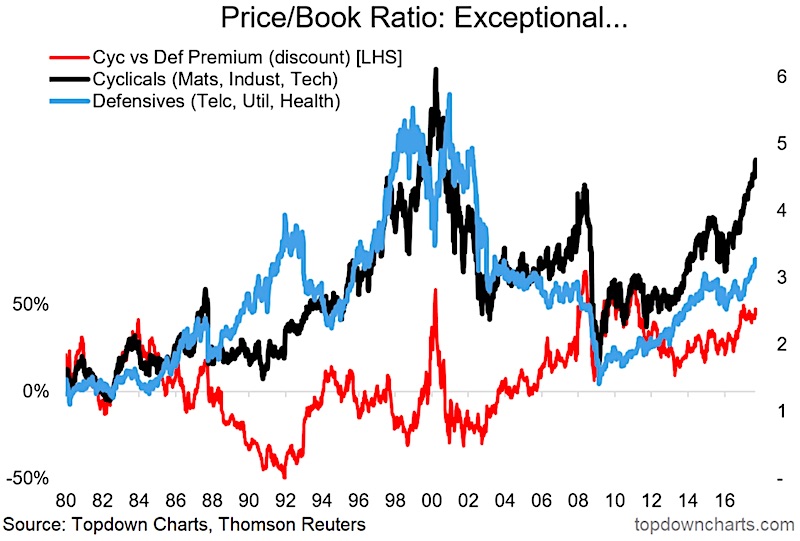I was running some analysis on cyclical vs defensive sectors and decided to take a look at the price to book ratios.
While we can argue about whether the Price To Book ratio (P/B) is the right metric, what’s clear is these indicators are at extreme levels. And since cyclical stocks have been a key cog in the bullish move higher, it makes sense to put this on your radar.
The chart below comes from the latest edition of the Weekly Macro Themes report in a running topic that covered a growing list of bearish indicators.
The chart in question is shown below. It shows the average P/B ratio for cyclical sectors, defensive sectors, and the ratio of cyclicals vs defensives (i.e. relative value).
Technical note: The cyclical sectors are: Basic materials, Industrials, and Technology. The defensive sectors are: Telecoms, Utilities, and Health care. The data is from the Thomson Reuters Datastream total market indexes. The readings in the chart are a non-weighted average across the sectors.
The main finding is that cyclicals look extremely expensive vs history. They also look very expensive vs defensive. Defensives also look increasingly expensive. The individual sectors also look expensive vs their own history e.g. basic materials and industrials are trading on Price/Book (P/B) ratios 2 standard deviations (SD) above their long term average, and 1 SD for technology. While health care and telecoms are trading in line with their long term average, utilities are trading almost 2 SD above their long term average – surely a result of the chase for yield.
Expensive valuations are not enough in and of themselves to be tactically bearish on equities – you need other factors to line up such as technicals/sentiment or a rolling over of the economics, or some other catalyst. They do however mean the stakes are higher, and the downside risk should one of these triggers come is steadily higher.
The reason this chart was included in my piece of analysis on bearish signals for US equities is that in this phase of the bull market any signs of vulnerabilities in cyclicals needs to be paid attention to as they have been a key source of strength. So it stands to reason that should cyclicals come unstuck they will most likely take the whole stock market down with them.
Twitter: @Callum_Thomas
Any opinions expressed herein are solely those of the author, and do not in any way represent the views or opinions of any other person or entity.









